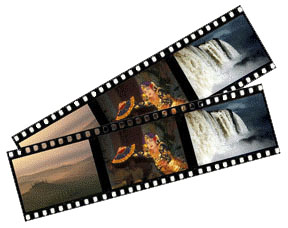 Two main types of slide or transparency film are available, although many manufacturers have now ceased or limited production. One is balanced for daylight, and the other for use in tungsten or artificial light. Slide film, more correctly known as colour reversal film, has a number of advantages. It has excellent colour saturation and sharpness, and produces positive first-generation images. When viewed on a light-box or a projection screen it is therefore possible to see transmitted light directly from the original image. This gives slides a vibrant translucence and particular appeal that cannot be matched by their negative counterparts. Because transparencies are easy to view, they are universally preferred by picture libraries and publishers.
Two main types of slide or transparency film are available, although many manufacturers have now ceased or limited production. One is balanced for daylight, and the other for use in tungsten or artificial light. Slide film, more correctly known as colour reversal film, has a number of advantages. It has excellent colour saturation and sharpness, and produces positive first-generation images. When viewed on a light-box or a projection screen it is therefore possible to see transmitted light directly from the original image. This gives slides a vibrant translucence and particular appeal that cannot be matched by their negative counterparts. Because transparencies are easy to view, they are universally preferred by picture libraries and publishers.
Using slide film is a somewhat different discipline to shooting with colour negative or black-and-white film. Composition must be done within the camera because opportunities for cropping at a later stage are very limited. Colour reversal stock also has a smaller dynamic range than colour negative, typically five stops as opposed to with seven, so exposures must be accurately controlled to within about one-third of a stop. It is also less tolerant of changes in colour temperature.
A collection of properly organized mounted slides forms a surprisingly convenient image library. Slide mounts provide just sufficient space to apply a label or bar-code to aid cataloguing. Individual images are relatively small but easy to handle, and can be stored in a number of convenient ways. The best storage medium is arguably the A4-sized 24-slide transparent plastic journal which can be stored on shelves like slim booklets. These can be placed directly on a light-box without the need to remove the slides from the journal. Slides stored in an appropriate dry and dark location have an extremely long life expectancy.






